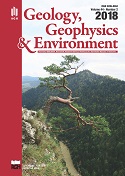On obtaining effective elasticity tensors with entries zeroing method
DOI:
https://doi.org/10.7494/geol.2018.44.2.259Keywords:
seismic, anisotropy, elasticity tensor, effective tensor, PSO, entries zeroing methodAbstract
The purpose of this paper is to propose a new method for obtaining tensors expressing certain symmetries, called effective elasticity tensors, and their optimal orientation. The generally anisotropic tensor being the result of in situ seismic measurements describes the elastic properties of a medium. It can be approximated with a tensor of a specific symmetry class. With a known symmetry class and orientation, one can better describe geological structure elements like layers and fissures. A method used to obtain effective tensor in the previous papers (i.e. Danek & Slawinski 2015) is based on minimizing the Frobenius norm between the measured and effective tensor of a chosen symmetry class in the same coordinate system. In this paper, we propose a new approach for obtaining the effective tensor with the assumption of a certain symmetry class. The entry zeroing method assumes the minimization of the target function, being the measure of similarity with the form of the effective tensor for the specific class. The optimization of orientation is made by means of the Particle Swarm Optimization (PSO) algorithm and transformations were parameterised with quaternions. To analyse the obtained results, the Monte-Carlo method was used. After thousands of runs of PSO optimization, values of quaternion parts and tensor entries were obtained. Then, thousands of realizations of generally anisotropic tensors described with normal distributions of entries were generated. Each of these tensors was the subject of separate PSO optimization, and the distributions of rotated tensor entries were obtained. The results obtained were compared with solutions of the method based on the Frobenius distances (Danek et al. 2013).
Downloads
References
Bona A., Bucataru I. & Slawinski M.A., 2004. Characterization of Elasticity-Tensor Symmetries Using SU(2). Journal of Elasticity, 75, 3, 267–289.
Danek T., Kochetov M. & Slawinski M.A., 2013. Uncertainty analysis of effective elasticity tensors using quaternion- based global optimization and Monte-Carlo method. The Quarterly Journal of Mechanics and Applied Mathematics, 66, 2, 253–272.
Danek T. & Slawinski M.A., 2015. On choosing effective elasticity tensors using a Monte-Carlo Method. Acta Geophysica, 63, 1, 45–61.
Dewangan P. & Grechka V., 2003. Inversion of multicomponent, multiazimuth, walkaway VSP data for the stiffness tensor. Geophysics, 68, 3, 1022–1031.
Diner C., Kochetov M. & Slawinski M.A., 2011. On choosing effective symmetry classes for elasticity tensors. The Quarterly Journal of Mechanics and Applied Mathematics, 64, 1, 57–74.
Eberhart R.C. & Shi Y., 2000. Comparing inertia weights and constriction factors in particle swarm optimization. [in:] Proceedings of the 2000 Congress on Evolutionary Computation: CEC00: July 16–19, 2000, La Jolla Marriott Hotel, La Jolla, California, USA, IEEE Service Center, 84–88.
Forte S. & Vianello M., 1996. Symmetry Classes for Elasticity Tensor. Journal of Elasticity, 43, 2, 81–108.
Gierlach B. & Danek T., 2017. Obtaining orthotropic elasticity tensor using entries zeroing method. [in:] EGU European Geosciences Union: general assembly 2017: Vienna, Austria, 23–28 April 2017, Geophysical Research Abstracts, 19, [on-line:] http://meetingorganizer. copernicus.org/EGU2017/EGU2017-438.pdf [access: 10.06.2018].
Hamilton W.R., 1844. On a new species of imaginary quantities connected with a theory of quaternions. Proceedings of the Royal Irish Academy, 2, 424–434.
Kennedy J. & Eberhart R.C., 1995. Particle swarm optimization. [in:] 1995 IEEE International Conference on Neural Networks: proceedings, the University of Western Australia, Perth, Western Australia, 27 November-1 December 1995, IEEE, 1942–1948.
Kochetov M. & Slawinski M.A., 2009. On obtaining effective orthotropic elasticity tensors. The Quarterly Journal of Mechanics and Applied Mathematics, 62, 2, 149–166.
Kozubal A., 2016. Global and local stochastic optimization in effective elasticity tensors evaluation. [in:] 15th International Conference on Geoinformatics – Theoretical and Applied Aspects (Geoinformatics 2016): Proceedings of a meeting held 10–13 May 2016, Kiev, Ukraine, EAGE, 454.
Poli R., Kennedy J. & Blackwell T., 2007. Particle swarm optimization – An overview. Swarm Intelligence, 1, 1, 33–57.
Shoemake K., 1985. Animating rotation with quaternion curves. ACM SIGGRAPH computer graphics, 19, 3, 245–254.
Slawinski M.A., 2010. Waves and Rays in Elastic Continua. World Scientific, Singapore.
Slawinski M.A., 2016. Wavefronts and rays in seismology. Answers to unasked questions. World Scientific, Singapore.
Downloads
Published
Issue
Section
License
Authors have full copyright and property rights to their work. Their copyrights to store the work, duplicate it in printing (as well as in the form of a digital CD recording), to make it available in the digital form, on the Internet and putting into circulation multiplied copies of the work worldwide are unlimited.
The content of the journal is freely available according to the Creative Commons License Attribution 4.0 International (CC BY 4.0)










